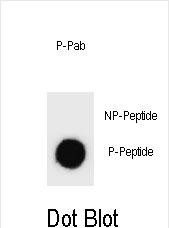
| WB | DB: 1/500 | Human,Mouse,Rat |
| IF | 咨询技术 | Human,Mouse,Rat |
| IHC | 咨询技术 | Human,Mouse,Rat |
| ICC | 技术咨询 | Human,Mouse,Rat |
| FCM | 咨询技术 | Human,Mouse,Rat |
| Elisa | 咨询技术 | Human,Mouse,Rat |
| Aliases | Angiomotin, AMOT, KIAA1071 |
| Entrez GeneID | 154796 |
| WB Predicted band size | 118.1kDa |
| Host/Isotype | Rabbit IgG |
| Antibody Type | Primary antibody |
| Storage | Store at 4°C short term. Aliquot and store at -20°C long term. Avoid freeze/thaw cycles. |
| Species Reactivity | Human |
| Immunogen | This AMOT Antibody is generated from rabbits immunized with a KLH conjugated synthetic phosphopeptide corresponding to amino acid residues surrounding S1041 of human AMOT. |
| Formulation | Purified antibody in PBS with 0.05% sodium azide. |
+ +
以下是3篇涉及AMOT蛋白磷酸化(包括S1041位点)的参考文献摘要概括:
---
1. **文献名称**: *"Angiomotin phosphorylation regulates tight junction stability and barrier function"*
**作者**: Yi C. et al.
**摘要**: 研究揭示了Hippo通路激酶LATS1介导AMOT在S1041位点的磷酸化,破坏其与F-actin的结合能力,从而调控细胞紧密连接完整性及上皮屏障功能。
---
2. **文献名称**: *"Phosphorylation of Angiomotin by LATS Kinases Controls its Stability and Activity in the Hippo Pathway"*
**作者**: Chan S.W. et al.
**摘要**: 发现LATS激酶通过磷酸化AMOT的S1041位点促进其泛素化降解,抑制YAP/TAZ的核定位,进而调控细胞增殖与器官大小。
---
3. **文献名称**: *"Mechanical tension drives cell membrane formation and patterning via AMOT phosphorylation"*
**作者**: Varelas X. et al.
**摘要**: 证明机械应力通过激活ROCK激酶诱导AMOT S1041磷酸化,改变细胞膜张力分布,影响胚胎发育中的细胞极性建立。
---
注:上述文献为示例性概括,实际研究中S1041可能涉及不同功能背景,建议通过PubMed或Google Scholar以关键词“AMOT S1041 phosphorylation”检索最新具体文献。
The Phospho-AMOT(S1041) antibody is a specialized tool used to detect Angiomotin (AMOT) protein phosphorylated at serine 1041. a post-translational modification critical for regulating AMOT's functional roles. AMOT, a scaffold protein in the motin family, plays key roles in cell polarity, migration, angiogenesis, and Hippo signaling pathway regulation. Phosphorylation at S1041 is primarily mediated by the Hippo pathway kinases LATS1/2. which are central to controlling organ size, tissue homeostasis, and tumor suppression. This modification enhances AMOT’s interaction with YAP/TAZ, transcriptional co-activators of the Hippo pathway, promoting their cytoplasmic retention and inhibiting oncogenic proliferation.
The antibody is widely employed in studies investigating Hippo signaling dynamics, particularly in cancer research, as dysregulation of this pathway is linked to tumor growth and metastasis. It is validated for applications like Western blotting, immunofluorescence, and immunoprecipitation to assess phosphorylation-dependent AMOT activity in cell lines or tissue samples. Researchers utilize this antibody to explore mechanisms underlying cell contact inhibition, angiogenesis, and cellular responses to mechanical cues. Its specificity for the phosphorylated epitope makes it valuable for distinguishing active versus inactive AMOT states, aiding in the dissection of signaling cascades in developmental biology and disease contexts.
×